2015 PEUGEOT 2008 isofix
[x] Cancel search: isofixPage 5 of 340

.
2008_en_Chap00a_sommaire_ed01-2015
Direction indicators 128
Hazard warning lamps 1 28
H or n
129
Emergency or assistance call
1
29
Tyre under-inflation detection
1
30
ESC system
1
33
Grip control
1
36
Front seat belts
1
38
Airbags
1
41
Safety
Fuel tank 159
Misfuel prevention (Diesel) 1 61
Running out of fuel (Diesel)
1
63
AdBlue
® additive and SCR system 1 64
(BlueHDi Diesel) 1 64
Temporary puncture repair kit
1
72
Changing a wheel
1
77
Snow chains
1
84
Changing a bulb
1
85
Changing a fuse
1
92
Battery
198
Electrical energy economy mode
20
1
Changing a wiper blade
2
02
To w i n g
2 0 3
Towing a trailer
2
05
Fitting roof bars
2
07
Advice on care and maintenance
2
07
Accessories
208
Practical information
B o n n e t 2 11
Petrol engines 2 12
Diesel engines
2
13
Checking levels
2
14
C h e c ks
2
17
Checks
General information 219
Petrol engines 2 20
Petrol weights
2
22
Diesel engines
2
24
Diesel weights
2
26
Dimensions
229
Identification markings
2
30
Technical data
Emergency call 2 32
Assistance call 2 33
7-inch touch screen
2
35
Audio system / Bluetooth
2
97
Audio system
3
17
Audio equipment and telematics
Alphabetical index
Child seats 1 45
Deactivating the passenger's front airbag 1 47
ISOFIX child seats
1
54
Child lock
1
58
Child safety
Lighting controls 1 11
Headlamp adjustment 1 18
Cornering lighting
1
19
Wiper controls
1
20
Lighting dimmer
1
24
Courtesy lamps
1
25
Interior mood lighting
1
26
Panoramic glazed sunroof
1
27
Visibility
Contents
Page 7 of 340

5
2008_en_Chap00b_vue-ensemble_ed01-2015
Interior
Boot fittings 74-77
- h igh load retaining net
-
par
cel shelf
-
b
oot lamp
-
r
etaining strap
-
la
shing rings
-
s
torage net
-
t
riangle de présignalisation Front seats
5 5 -56
Child seats
1
45 -153
ISOFIX child seats
1
54-157
Manual child lock
1
58
Electric child lock
1
58 A ir bags
141-14 4
Interior fittings
7
0-73
-
i
lluminated glove box
-
1
2 V accessory socket
-
U
SB port / Auxiliary socket
-
mats
Deactivating the passenger's front airbag
1
42, 147
Seat belts
1
38-140
Rear seats
5
7-58
.
Over view
Page 77 of 340
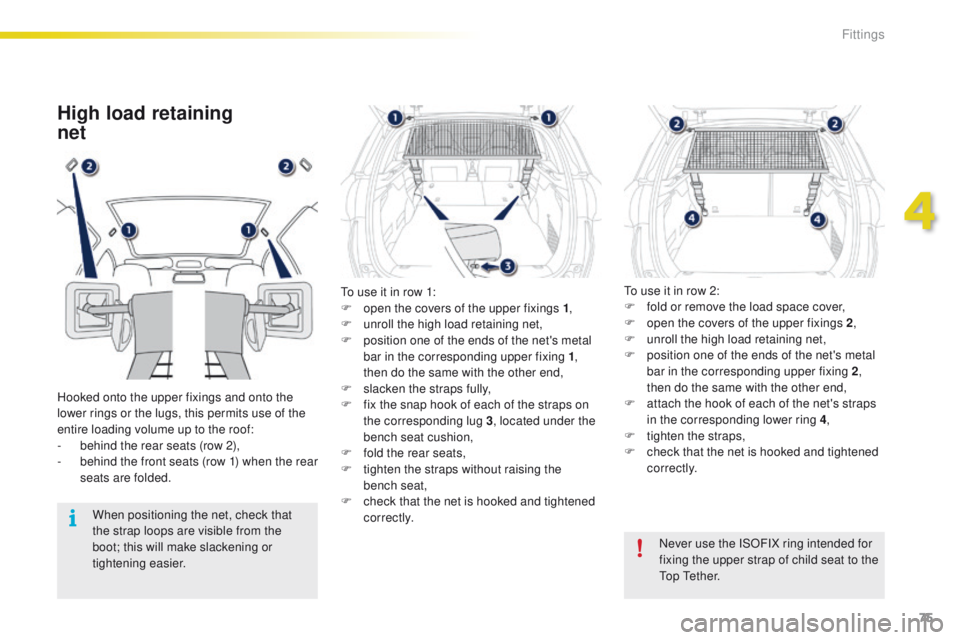
75
2008_en_Chap04_amenagements_ed01-2015
High load retaining
net
Hooked onto the upper fixings and onto the
lower rings or the lugs, this permits use of the
entire loading volume up to the roof:
-
b
ehind the rear seats (row 2),
-
b
ehind the front seats (row 1) when the rear
seats are folded.
When positioning the net, check that
the strap loops are visible from the
boot; this will make slackening or
tightening easier. Never use the ISOFIX ring intended for
fixing the upper strap of child seat to the
Top Tether.
To use it in row 1:
F
o
pen the covers of the upper fixings 1
,
F
u
nroll the high load retaining net,
F
p
osition one of the ends of the net's metal
bar in the corresponding upper fixing 1 ,
then do the same with the other end,
F s lacken the straps fully,
F f ix the snap hook of each of the straps on
the corresponding lug 3 , located under the
bench seat cushion,
F
f
old the rear seats,
F
t
ighten the straps without raising the
bench
seat,
F
c
heck that the net is hooked and tightened
c o r r e c t l y. To use it in row 2:
F
f
old or remove the load space cover,
F
o
pen the covers of the upper fixings 2
,
F
u
nroll the high load retaining net,
F
p
osition one of the ends of the net's metal
bar in the corresponding upper fixing 2 ,
then do the same with the other end,
F a ttach the hook of each of the net's straps
in the corresponding lower ring 4 ,
F
t
ighten the straps,
F
c
heck that the net is hooked and tightened
c o r r e c t l y.
4
Fittings
Page 147 of 340
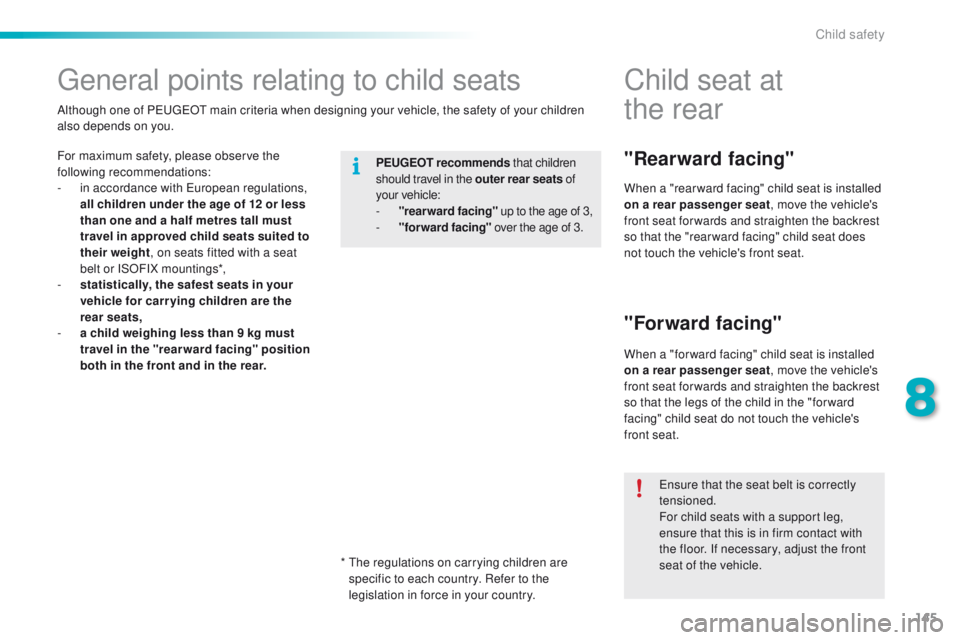
145
2008_en_Chap08_securite-enfants_ed01-2015
General points relating to child seats
For maximum safety, please observe the
following recommendations:
-
i
n accordance with European regulations,
all children under the age of 12 or less
than one and a half metres tall must
travel in approved child seats suited to
their weight , on seats fitted with a seat
belt or ISOFIX mountings*,
-
s
tatistically, the safest seats in your
vehicle for carr ying children are the
rear seats,
-
a c
hild weighing less than 9 kg must
travel in the "rear ward facing" position
both in the front and in the rear. PEUGEOT recommends
that children
should travel in the outer rear seats of
your vehicle:
-
"
rearward facing" up to the age of 3,
-
"
forward facing" over the age of 3.
Although one of PEUGEOT main criteria when designing your vehicle, the safety of your children
also depends on you.
*
T
he regulations on carrying children are
specific to each country. Refer to the
legislation in force in your country.
Child seat at
the
rear
"Rearward facing"
"Forward facing"
When a "rear ward facing" child seat is installed
on a rear passenger seat , move the vehicle's
front seat for wards and straighten the backrest
so that the "rear ward facing" child seat does
not touch the vehicle's front seat.
When a "for ward facing" child seat is installed
on a rear passenger seat , move the vehicle's
front seat for wards and straighten the backrest
so that the legs of the child in the "for ward
facing" child seat do not touch the vehicle's
front seat.
Ensure that the seat belt is correctly
tensioned.
For child seats with a support leg,
ensure that this is in firm contact with
the floor. If necessary, adjust the front
seat of the vehicle.
8
Child safety
Page 152 of 340
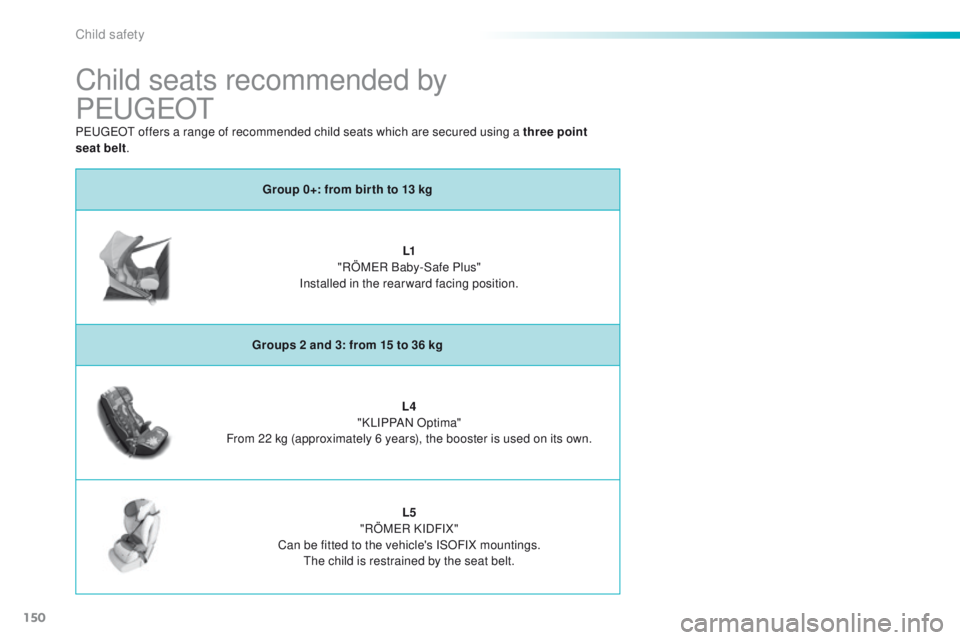
150
2008_en_Chap08_securite-enfants_ed01-2015
Child seats recommended by
PEUGEOT
Group 0+: from bir th to 13 kgL1
"RÖMER Baby-Safe Plus"
Installed in the rearward facing position.
Groups 2 and 3: from 15 to 36 kg L4
"KLIPPAN Optima"
From 22 kg (approximately 6 years), the booster is used on its own.
L5
"RÖMER KIDFIX"
Can be fitted to the vehicle's ISOFIX mountings. The child is restrained by the seat belt.
PEUGEOT offers a range of recommended child seats which are secured using a three point
seat
belt
.
Child safety
Page 156 of 340
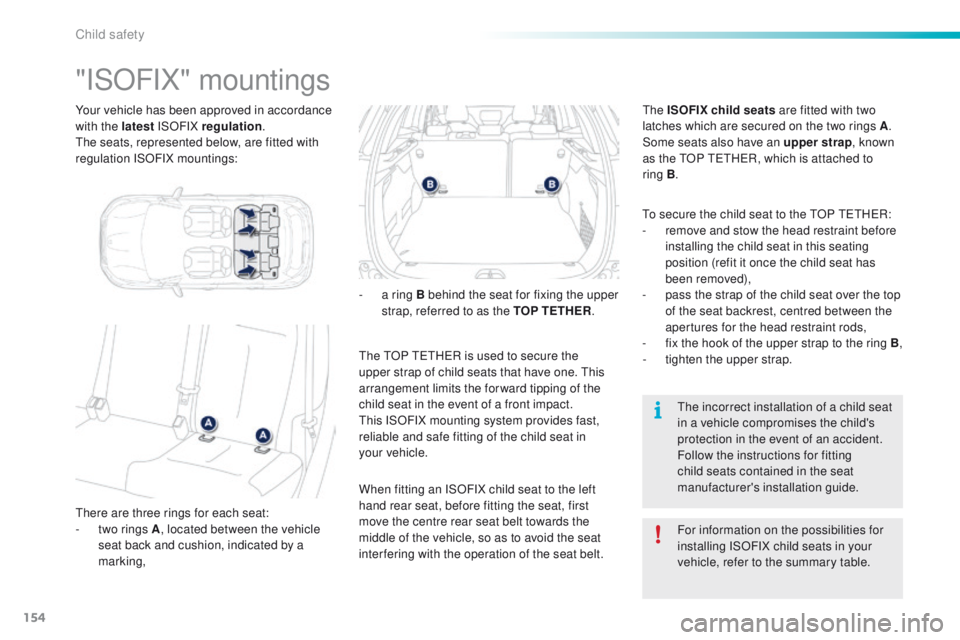
154
2008_en_Chap08_securite-enfants_ed01-2015
Your vehicle has been approved in accordance
with the latest ISOFIX regulation .
The seats, represented below, are fitted with
regulation ISOFIX mountings:
"ISOFIX" mountings
There are three rings for each seat:
- t wo rings A , located between the vehicle
seat back and cushion, indicated by a
marking, When fitting an ISOFIX child seat to the left
hand rear seat, before fitting the seat, first
move the centre rear seat belt towards the
middle of the vehicle, so as to avoid the seat
interfering with the operation of the seat belt.
For information on the possibilities for
installing ISOFIX child seats in your
vehicle, refer to the summary table.
-
a r
ing B behind the seat for fixing the upper
strap, referred to as the TOP TETHER .
The TOP TETHER is used to secure the
upper strap of child seats that have one. This
arrangement limits the forward tipping of the
child seat in the event of a front impact.
This ISOFIX mounting system provides fast,
reliable and safe fitting of the child seat in
your
vehicle.To secure the child seat to the TOP
TETHER
:
-
r
emove and stow the head restraint before
installing the child seat in this seating
position (refit it once the child seat has
been removed),
-
p
ass the strap of the child seat over the top
of the seat backrest, centred between the
apertures for the head restraint rods,
-
f
ix the hook of the upper strap to the ring B,
-
t
ighten the upper strap.
The incorrect installation of a child seat
in a vehicle compromises the child's
protection in the event of an accident.
Follow the instructions for fitting
child seats contained in the seat
manufacturer's installation guide.
The ISOFIX child seats are fitted with two
latches which are secured on the two rings A
.
Some seats also have an upper strap , known
as the TOP TETHER, which is attached to
ring B
.
Child safety
Page 157 of 340
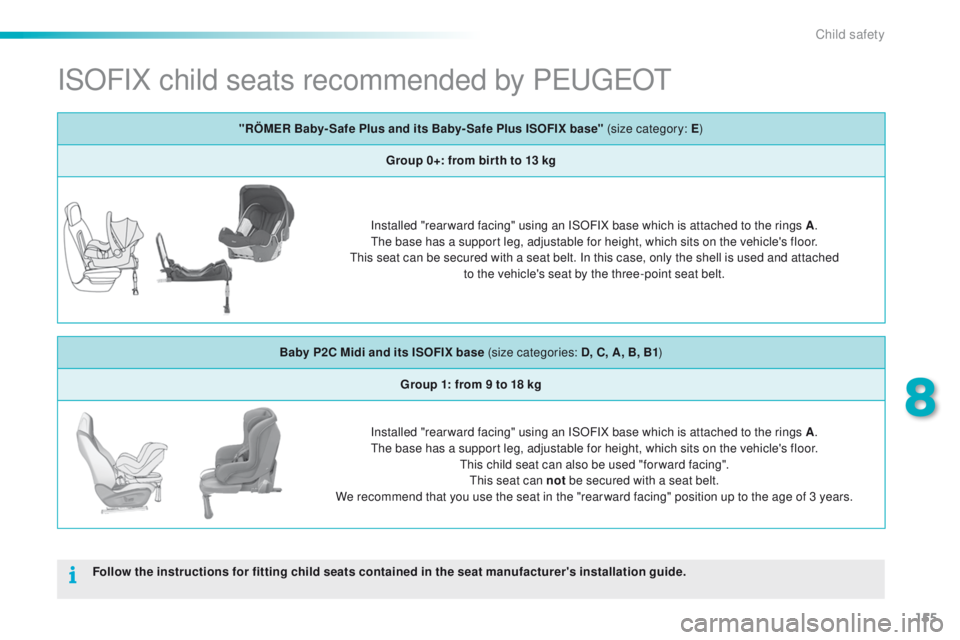
155
2008_en_Chap08_securite-enfants_ed01-2015
ISOFIX child seats recommended by PEUGEOT
Follow the instructions for fitting child seats contained in the seat manufacturer's installation guide."RÖMER Baby- Safe Plus and its Baby- Safe Plus ISOFIX base" (size category: E
)
Group 0+: from bir th to 13 kg
Installed "rear ward facing" using an ISOFIX base which is attached to the rings A .
The base has a support leg, adjustable for height, which sits on the vehicle's floor.
This seat can be secured with a seat belt. In this case, only the shell is used and attached to the vehicle's seat by the three-point seat belt.
Baby P2C Midi and its ISOFIX base (size categories: D, C, A, B, B1 )
Group 1: from 9 to 18 kg
Installed "rear ward facing" using an ISOFIX base which is attached to the rings A .
The base has a support leg, adjustable for height, which sits on the vehicle's floor. This child seat can also be used "for ward facing".This seat can not be secured with a seat belt.
We recommend that you use the seat in the "rear ward facing" position up to the age of 3 years.
8
Child safety
Page 158 of 340
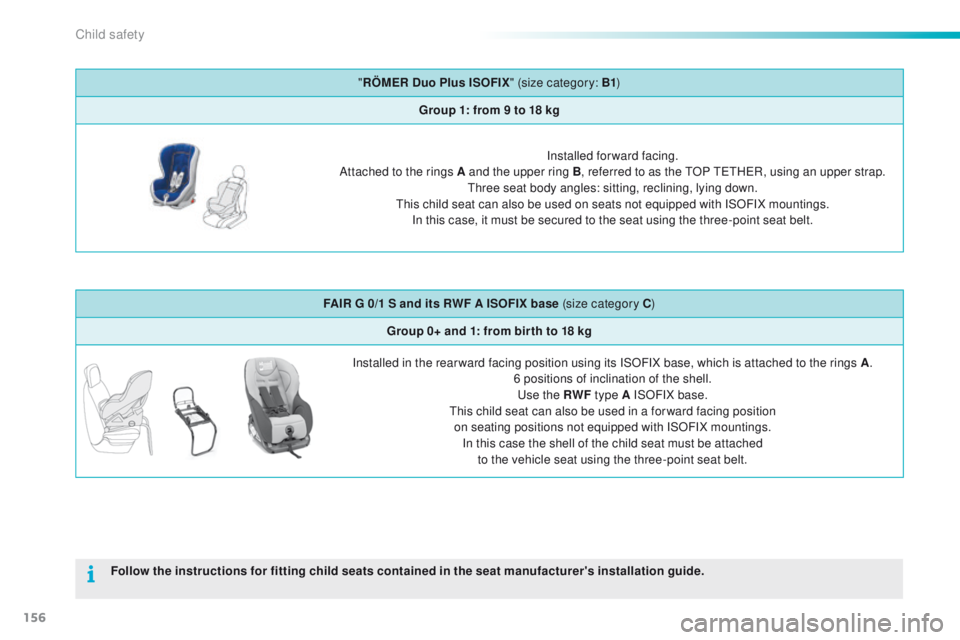
156
2008_en_Chap08_securite-enfants_ed01-2015
"RÖMER Duo Plus ISOFIX " (size category: B1)
Group 1: from 9 to 18 kg
Installed forward facing.
Attached to the rings A and the upper ring B, referred to as the TOP TETHER, using an upper strap. Three seat body angles: sitting, reclining, lying down.
This child seat can also be used on seats not equipped with ISOFIX mountings. In this case, it must be secured to the seat using the three-point seat belt.
FAIR G 0/1 S and its RWF A ISOFIX base (size category C)
Group 0+ and 1: from bir th to 18 kg
Installed in the rear ward facing position using its ISOFIX base, which is attached to the rings A .
6 positions of inclination of the shell. Use the RWF type A ISOFIX base.
This child seat can also be used in a for ward facing position on seating positions not equipped with ISOFIX mountings. In this case the shell of the child seat must be attached to the vehicle seat using the three-point seat belt.
Follow the instructions for fitting child seats contained in the seat manufacturer's installation guide.
Child safety